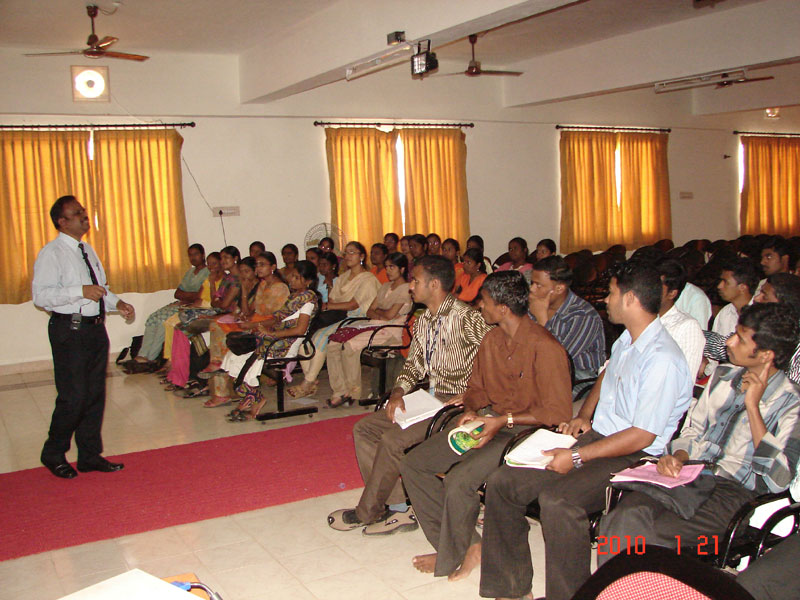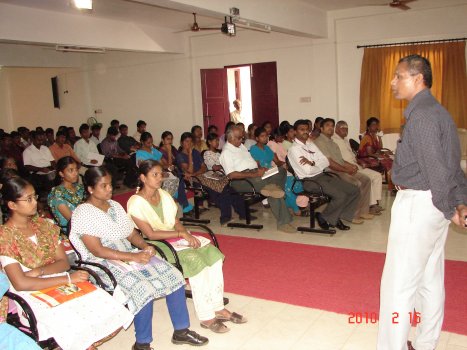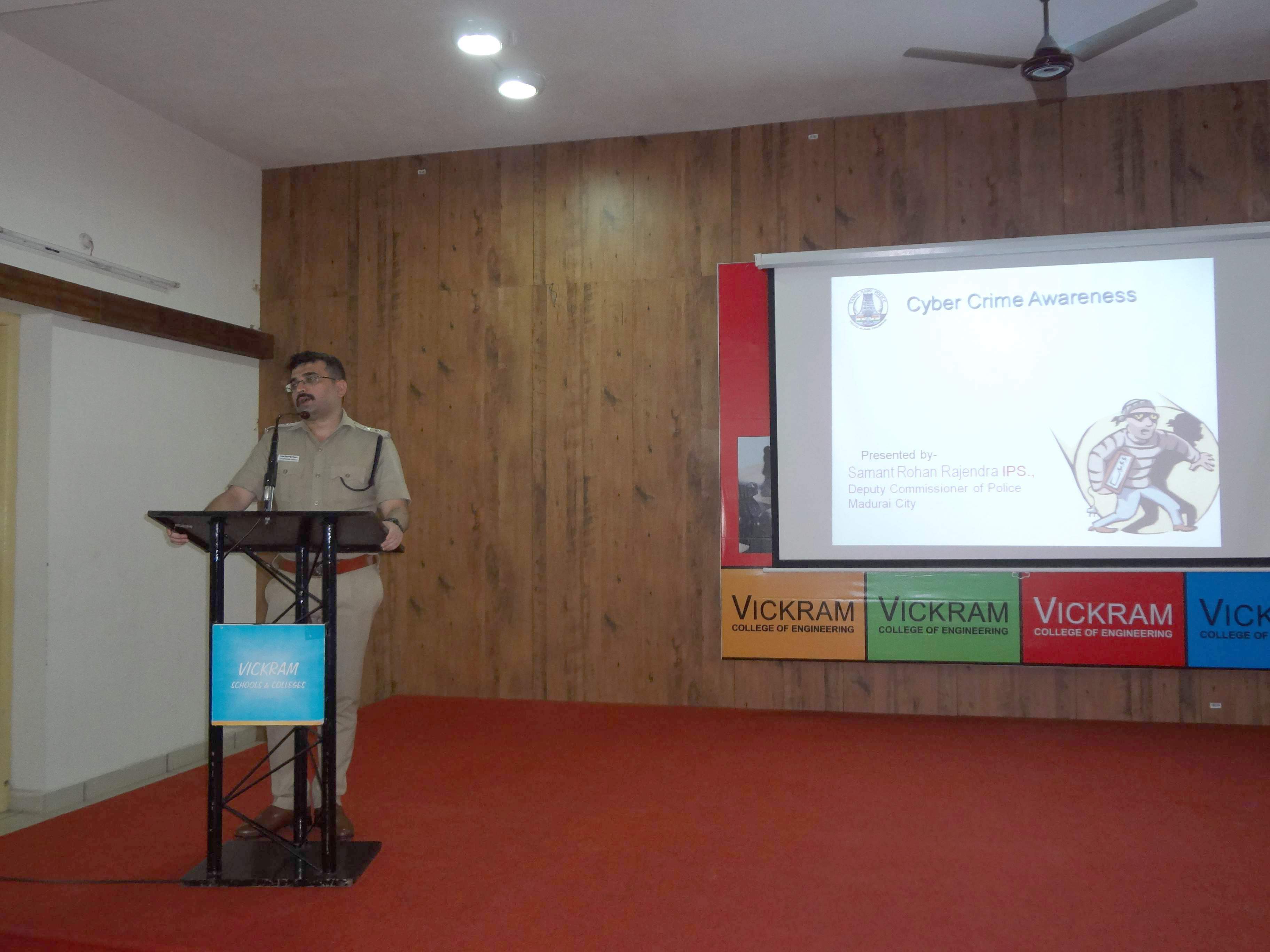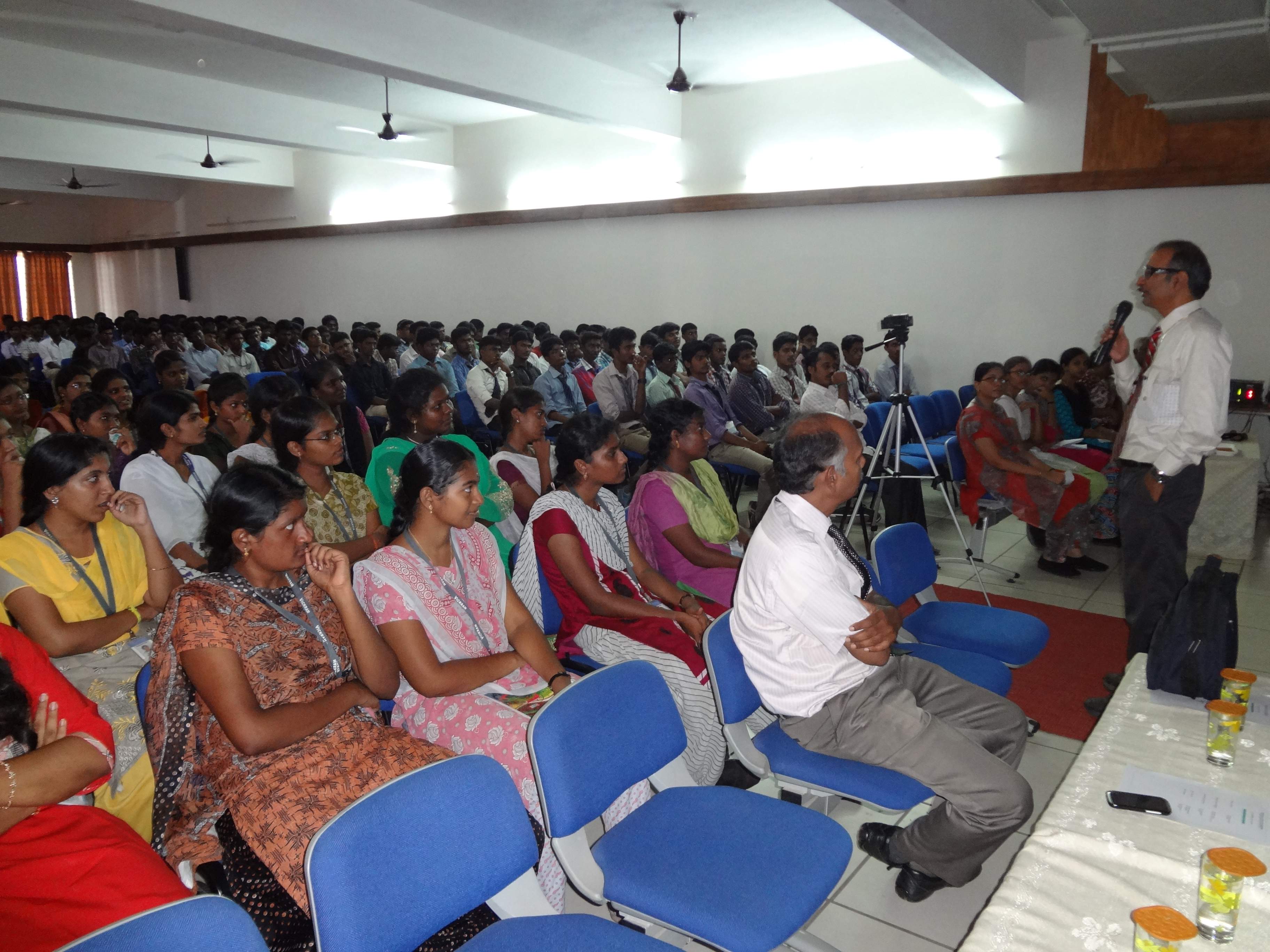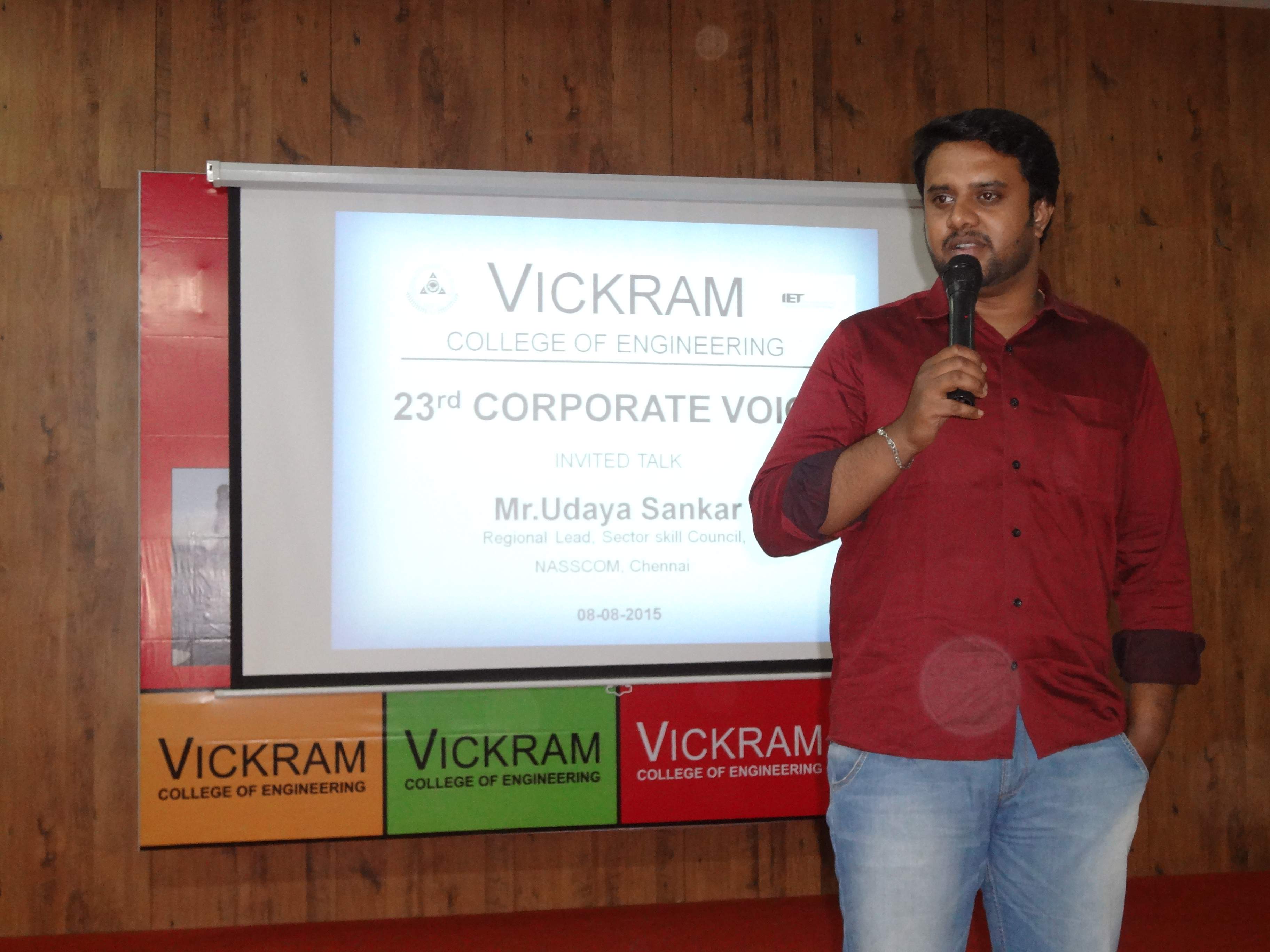- Written by jeyapaul
- Hits: 2038
Seminar on Energy Simulation & Conservation on 16th Feb 2010
There was a Seminar organized on 16th Feb 2010 by the Department of EEE on Energy Simulation & Conservation by Sri S.A.S. Syed Ahmed, Deputy General Manager, Tamilnadu Energy Development Agency(TEDA), Madurai. At the outset, Sri S.A. Syed Ahmed explained the importance of energy in the life of mankind. Then he listed various kinds of natural resources, through the means of which we derive energy.
Renewable & Non-Renewable Sources of Energy: Energy sources are classifiable under two headings – namely, conventional sources, and renewable sources. India is endowed with abundance of natural resources such as solar, wind, biomass etc., which can supply the energy needed even in remote areas. These are also called as alternative or renewable sources of energy because they are either inexhaustible or can be replenished with human effort. Of course, we use the latest technologies in extracting power from the various renewable energy sources, such as wind, solar, bioenergy, ocean and geo-thermal etc. It is true that the initial cost is high, because of the installation devices, which cost more. But the benefits are long standing. As the awareness on renewable energy improves, it is hoped that more beneficiaries will come forward to use them and the initial cost will come down whereas under conventional energy, recurring cost always keeps increasing every year.
The renewable energy sources have certain advantages. One, they are inexhaustible, such as solar energy, wind energy, tidal energy. Two, they have universal availability. Three, the cost of production and operation is low. Four, they cause no degration of our environment through pollution or emission of Greenhouse Gases. The non-renewable resources mostly come from fossil fuels, called petroleum & coal. Because of their increased use, there is a problem of depleting these non-renewable resources. Besides, these non-renewable energy sources cause pollution and environmental degradation due to Green House Gas emissions.
Atomic Energy: Then Sri S.A.S. Syed Ahmed highlighted the two instances of power generation through the use of atomic energy. At present, India has ten nuclear power reactors in commercial operation – one at Kalpakkam, and the other at Koodankulam in Tamilnadu. It takes about 13,500 crores for generating 1000 MW. So it costs Rs.13.5 crores per 1 MW generation. The major drawbacks are that the commissioning period is too long. For instance, Koodankulam atomic station took nearly 12 years for its installation and power generation. Besides, there is a danger of nuclear accidents or radiations caused by hazardous wastes.
Solar Energy: While talking about solar energy, Sri S.A.S. Syed Ahmed observed that solar radiation sustains all forms of life on earth. According to estimates, sun radiates about 1.74 x 1017 W of power per hour to earth.. The daily solar energy incidence varies from 4 – 7 kWh per m2 and there are 250 to 300 sunny days in a year. The power potential of solar energy is 20 MW per sq.km. There are two categories called Solar Photo Voltaic (SPV) and Solar Thermal (ST). In India the maximum power generated by solar cell by a stand-alone power station is 2 MW. The main component for solar power plant is silicon-mono crystalline. The major drawbacks are that it requires large area. For example, for generation of 1 MW, the space required is 5 acres.
The Guest Speaker also commented on solar water heating system (SWHS). Solar water heater heats the water to 400C which is directly used for bathing purpose. This device supplies hot water at 60°C to 80°C using only solar thermal energy without any other fuel. The main economical advantage is that it saves about 1500 units of electricity per annum equivalent to about Rs.5000/- per year. The payback period would be about 3 years against the life of 15 years and above for the system. The government gives liberal incentives for solar power generation. A maximum amount of Rs.12.00 per Kwh will be provided as incentive for electricity generated from solar photovoltaics and Rs.10.00 per Kwh for electricity generated through the solar thermal route and fed to the grid from a power plant of minimum 1 MW capacity and above
Wind Energy: Then Sri S.A.S. Syed Ahmed talked about wind energy. Wind is generated due to heating of the earth’s surface. Uneven heating of different areas of earth causes difference in pressure and makes the air flow from high pressure region to low pressure region, which is termed as “Wind”. As wind contains tremendous amount of energy, it can be harnessed to generate power on a large scale matching with conventional sources. Initially, in India, wind mills were installed at the capacity of 250 KW only. But now the capacity is improved to 1.5 MW range. Tamil Nadu has installed capacity of 4287 MW accounts for 42 % and is No. 1 State in the country. The potential areas in Tamilnadu are Aralvaimozhi Pass (Muppandal area), Sengottah Pass (Kayathar area), Palghat Pass (Kethanur area) Coimbatore, Coastal area near Chennai and Rameswaram. The high wind prone zones are areas with annual mean wind speed of 18 kmph and above and annual mean Wind Power Density ( WPD ) of 150 W / m2 and above, at 50 m height. The Capital cost is 1/3rd of solar energy. In Kanyakumari , wind energy is available only for a period of 9 months in a year. The rest of the months, it could not be made available, and it is called seasonal energy. Of course, the government gives more subsidies to windmill erection. The subsidy for wind mill is 2.5*c up to 0.65 lakhs, where c is the capacity in MW. The major drawback is that there are no trained persons for maintenance.
Hybrid Power Generation: The latest method of power generation is hybrid power station in which the combination of both solar energy and wind energy are used to generate power. In this power station, solar cells are installed in the wind mill towers.
Bio-Energy: Bio-energy refers to energy derived from all kinds of organic wastes which are available in plenty in nature and at relatively lesser cost than fossil fuels and is also free from pollution. The different sources of bioenergy are Bio-mass, Bio-degradable waste and Bio-fuels. Biomass is produced by green plants through photosynthesis using sunlight and contains organic matter which can be converted to energy and replenished by human effort. Biomass can be broadly classified into three categories, namely Field level residues (Paddy straw, stalks of various crops etc. ),Plantation crop residues ( coconut residues like fronts, stems, Palmyra tree residues etc.) and Agro industry residues. Biomass today accounts for over one-third of all energy used in the developing countries. The estimated power generation potential from biomass in India is about 19000 MW. Biodegradable organic wastes, such as cow dung, kitchen waste, poultry litter, night soil etc. can be potential energy sources when they are subjected to anaerobic digestion. Biogas plants work on bio-methanation principle to produce methane and carbon-di-oxide.
Contribution of Tamilnadu in Harnessing Renewable Energy: Tamil Nadu has achieved tremendous success in harnessing renewable energy for generation of grid quality power. It has an installed capacity of 4790 MW from renewable sources which accounts for about 32% of TNEB's total grid capacity of about 15,100 MW. In respect of wind power, Tamil Nadu is No. 1 in India with an installed capacity of 4287 MW, which is about 44% of the total installed capacity in India. Besides, Tamil Nadu is a pioneer in introducing cogeneration in sugar mills and continues to lead with installed capacity of 466 MW.

